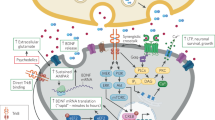Overview
- Editors:
-
-
Robert A. Rush
-
Department of Human Physiology, Flinders University, Adelaide, Australia
Access this book
Other ways to access
About this book
The past decade has seen an extraordinary growth in research interest in neurotrophic factors, and the study of the neurotrophin family has led this activity. Nevertheless, this area of research has often struggled as a result of techniques that were either inadequate or just emerging from other research fields and disciplines. Neurotrophin Protocols has brought together many leaders in the neurotrophin field who detail their special expertise in a wide variety of techniques. Though most procedures are valid across many diff- ent fields of research, some of those described here have been developed to address particular issues within the neurotrophic factor field. The protocols cover a broad range of biochemical, histological, and biological techniques that are often required by the modern laboratory. However, all have been written with sufficient detail to allow any laboratory to achieve proficiency without need of reference to other texts. Neurotrophin Protocols is divided into four sections dealing with p- tein, RNA, recombinant, and in vivo techniques. Protein techniques have in general been less successfully employed than those dealing with RNA or DNA. However, procedures that achieve localization and quantification of the neurotrophins are now being used more extensively. Their inclusion here should assist further studies at the protein level. Transgenic cell lines and animals are commonplace in the scientific research literature, but their inc- sion in several chapters in this book provide some novel uses that are not readily available elsewhere.
Similar content being viewed by others
Article
06 September 2023
Table of contents (18 protocols)
-
In Vivo Analysis
-
- W. Ruwan Epa, Graham L. Barrett, Perry F. Bartlett
Pages 223-242
-
- Ian A. Hendry, Anna J. Reynolds
Pages 243-250
-
- Victor Nurcombe, Nigel G. Wreford, John F. Bertram
Pages 251-268
-
Back Matter
Pages 269-274
Reviews
"...provides a collection of chapters written by experts in developmental neuroscience, neuroanatomy, signaling mechanisms that regulate neuronal survival and plasticity, and neurodegenerative disorders....This book will be a valuable addition to libraries at Universities and various other institutes engaged in biomedical sciences, as well as to the personal collection of those scientists interested in growth factors....A strength of Neurotrophin Protocols is that it covers considerable ground with little repetition of background information and specific methods among chapters....we expect that this book will spend less time on the shelf and more time on lab benches and office desks. This is well done and timely contribution to the field of neurotrophic factor research."-Journal of Molecular Neuroscience
Editors and Affiliations
-
Department of Human Physiology, Flinders University, Adelaide, Australia
Robert A. Rush



